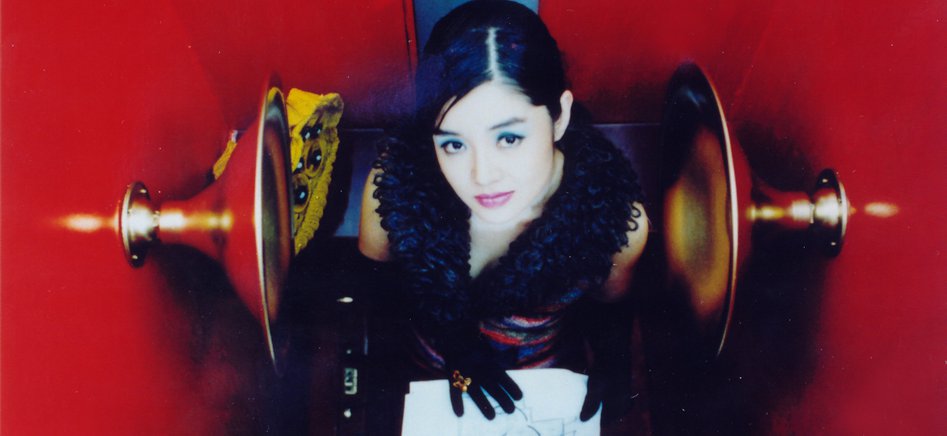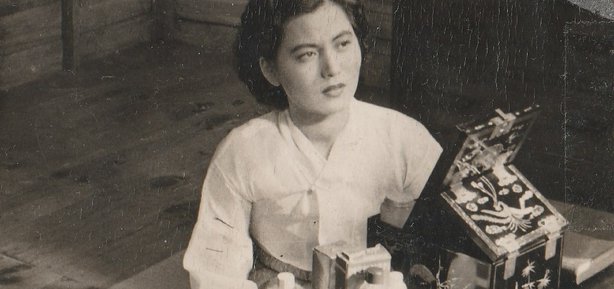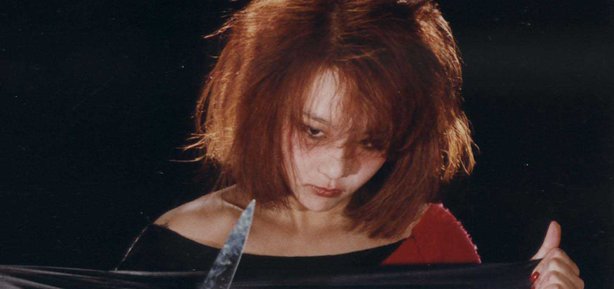When Park Nam-ok set out to shoot The Widow in the summer of 1954, South Korea was still lifting itself out of the ruins of the Korean War. Park, a huge film fan in her teens, had written film reviews and tried to enter the film world in the late 1940s. She could only make it as far as the role of ‘scripter’ (a.k.a. ‘continuity girl’) for what happened to be Choi Eun-hee’s debut film in 1947. She joined a Ministry of Defense film unit during the war, where she gained crucial experience and made useful friendships. To create this first Korean film by a woman director, Park Nam-ok put together some money from her sister and obtained the help of a film-veteran and former neighbour, Jeon Chang-keun, who served as producer – he was her version of a Park Chan-wook. She cast the lovely rising star Lee Min-ja as her Shinja. Despite all that, the film was not a success nor did Park find a way to continue her career.
There is a much reproduced photo of her taken during the shoot, looking care-worn, her baby girl on her back. Film scholars have written about the sacrifices Park made to get the film completed, with apparently no help in caring for that little girl. In later life, she herself preferred a different, unsentimental photo: at a 1962 film festival in Tokyo, Park stands, in formal hanbok, next to top Korean star Kim Jin-kyu as Japanese superstar Mifune Toshiro leans over to light her cigarette.
Park Nam-ok’s The Widow deftly resists the pull of melodrama. A conventional approach might have protagonist Shinja wracked by guilt over neglecting her daughter and/or sleeping with a new man, the daughter could come down with some horrible disease and Shinja be forced to give herself to her patron, etc., etc. At least one critic has even suggested that Park’s lack of sentimentality was simply due to her lack of experience in proper (melo?) film-making. The Widow still seems a worthy forerunner to the women’s films which would follow.
During the 1960s film production soared. From some 100 features made in 1959, close to 200 would become the average. Despite the need for more directors, only two women had the chance to step behind the camera for significant productions. Hong Eun-won began as scripter, then fully-fledged scriptwriter before shooting her first film A Woman Judge in 1962. The film screened in the Special Focus section of LKFF 2019. Hong only made two more films, neither of which survive, before returning to scriptwriting. Something like a pattern was emerging in which women might be given three chances to direct, but producers were reluctant to let them develop a real career. Certainly the odds were never good.
Choi Eun-hee was already one of the biggest stars of the fifties and sixties before she made the first of her three films, Daughter-in-Law, in 1965. Her husband, Shin Sang-ok, already a major film director and producer, was just about to establish Korea’s largest studio, Shin Films. It may be hard to judge what degree of creativity Choi herself brought to the rather conventional and melodramatic story; the script was based on a popular radio series. While even her acting skills may not persuade us that Jum-soon really is a twenty-something, the relationship which develops between Choi/Jum-soon and the little master conveys a real sense of warmth and affection. The film was a success.
A Princess’ One-Sided Love (1968), from two years later, is a lively costume drama set the middle of the Joseon era. It is refreshingly free of sentimentality and high-seriousness. Shin Films had the resources to produce a number of sagŭk historical dramas, but few achieve the humour of Choi’s. If only it had been shot in colour! Audiences nowadays can still appreciate how comically outrageous princess Sook-kyung’s behaviour is: chasing a man -- lower-status at that, defying her mother, insulting her grandfather, prowling the capital dressed as a man. As part of the film’s promotion, a special pre-release screening was held for a women-only audience. Maybe just a gimmick, but it would be nice to know what the reaction had been.
Hwang Hye-mi was the lone woman director of commercial films active in the 1970s. She entered the film industry, as it were, from the top. Hwang had helped to produce films by the veteran Kim Soo-yong and her friend, writer-turned director Kim Seung-ok, before directing three films herself between 1970-72. First Experience (1970), a romantic melodrama, was well received by critics and the public. Yet no print survives of it nor of her two other melodramas.
 김보라, 차진엽 안무가 등 한국 여성 안무가 4인이 참여하는 현대무용축제 런던에서 개최
김보라, 차진엽 안무가 등 한국 여성 안무가 4인이 참여하는 현대무용축제 런던에서 개최
 한국 문화 예술원 : 개원 소식
한국 문화 예술원 : 개원 소식
 한인 교육기금: 재영한인교육기금은 KEF교육기금으로 기관명을 변경하여...
한인 교육기금: 재영한인교육기금은 KEF교육기금으로 기관명을 변경하여...
 주영 한국 문화원 : Introducing our Spring/Summer programme here at the KCCUK
주영 한국 문화원 : Introducing our Spring/Summer programme here at the KCCUK
 주영 한국 문화원 : A Viewing Room: Taey lohe
주영 한국 문화원 : A Viewing Room: Taey lohe


